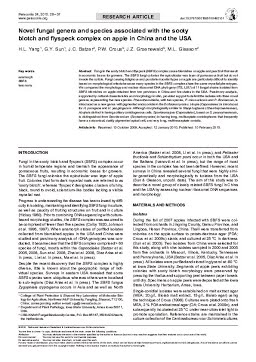2010
Novel fungal genera and species associated with the sooty blotch and flyspeck complex on apple in China and the USA
Publication
Publication
Persoonia - Molecular Phylogeny and Evolution of Fungi , Volume 24 - Issue 1 p. 29- 37
Fungi in the sooty blotch and flyspeck (SBFS) complex cause blemishes on apple and pear fruit that result in economic losses for growers. The SBFS fungi colonise the epicuticular wax layer of pomaceous fruit but do not invade the cuticle. Fungi causing fuliginous and punctate mycelial types on apple are particularly difficult to identify based on morphological criteria because many species in the SBFS complex share the same mycelial phenotypes. We compared the morphology and nuclear ribosomal DNA phylogeny (ITS, LSU) of 11 fungal strains isolated from SBFS blemishes on apple obtained from two provinces in China and five states in the USA. Parsimony analysis, supported by cultural characteristics and morphology in vitro, provided support to delimit the isolates into three novel genera, representing five new species. Phaeothecoidiella, with two species, P. missouriensis and P. illinoisensis, is introduced as a new genus with pigmented endoconidia in the Dothideomycetes. Houjia (Capnodiales) is introduced for H. pomigena and H. yanglingensis. Although morphologically similar to Stanjehughesia (Chaetosphaeriaceae), Houjia is distinct in having solitary conidiogenous cells. Sporidesmajora (Capnodiales), based on S. pennsylvaniensis, is distinguished from Sporidesmium (Sordariomycetes) in having long, multiseptate conidiophores that frequently have a subconical, darkly pigmented apical cell, and very long, multi-euseptate conidia.
| Additional Metadata | |
|---|---|
| , , | |
| Persoonia - Molecular Phylogeny and Evolution of Fungi | |
| Released under the CC-BY 4.0 ("Attribution") License | |
| Organisation | Naturalis journals & series |
|
Yang, H. L., Sun, G. Y., Batzer, J. C., Crous, P. W., Groenewald, J. Z., & Gleason, M. L. (2010). Novel fungal genera and species associated with the sooty blotch and flyspeck complex on apple in China and the USA. Persoonia - Molecular Phylogeny and Evolution of Fungi, 24(1), 29–37. |
|
